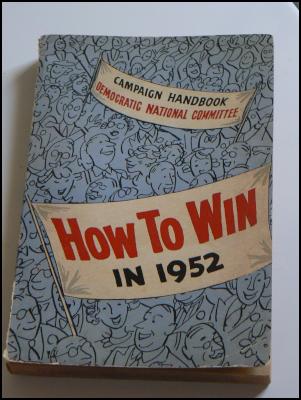An Occasional Note on the 2008 Campaigns, No. 8
An Occasional Note on the 2008 Campaigns, No. 8
After watching the Democratic candidates debate on Wednesday evening, and Republican John McCain’s interview on This Week on Sunday, I am casting about the world for some other country’s election to vote in come November. Any country. Just please let me not have to vote in this one here in the U.S.
All three candidates—yes, A-L-L—are tragedies waiting to foist themselves on the world. I had to take solace by doing a little time traveling.

Click for big version
::How to Win in
1952::
This little gem was put out by the Democratic
National Committee after the presidential and vice
presidential candidates had been chosen at the July
nominating convention. Convention delegates took three ballots to settle on a
presidential candidate.
Fat lot of good this campaign handbook did the Democratic Party.
In the 1952 election, not only was a Republican elected to the White House by an overwhelming majority of Electoral College votes—442 to 89—but Republicans won the House 221 to 213, and the Senate 48 to 47. Slim margins in Congress, but the election put to an end the “long twenty-year control of at least one or more of the three branches of government by the Democratic Party,” according to House Historian Robert V. Remini in his book The House.
The presidential candidate selected by the Republicans in 1952 was General Dwight D. Eisenhower, who promised to bring U.S. involvement in the war in Korea to an end. The vice presidential selection was newbie Senator Richard Nixon. Since the Republican convention had taken place weeks before the Democratic one, the campaign handbook was able to include attacks on them.
Although not directly referring to his inexperience, the handbook lists Senator Nixon’s record as serving in the House from 1947-1950 and the Senate since 1950. Given that Nixon was impeached after garnering another two decades experience in DC, the benefit of hindsight seems to indicate the folly of valuing lengthy experience in a presidential candidate. (Have I used the word “experience” Clintonially enough?)
At their 1952 convention, the Democrats chose Adlai Stevenson—a lawyer and Governor of Illinois—to run for President with John Sparkman—a Southerner who, this handbook says, “led the fight that blasted the Dixiecrats out of control in Alabama,” from where he had first been elected to Congress in 1936. (Kinda awkward to have someone so strongly associated with segregationist Strom Thurmond on the ticket when one of the Democrats’ platforms was civil rights.)
It was a completely different world back then, of course, as can be seen by the issues that were used to highlight the differences between the two parties: “Republicans work for the giant millers and bakers—Democrats work for the farmers and consumers.” But some things remain the same, as in this excerpt.
Smear
and Fear: Twin Threat to Democracy
Today we are getting
from many Republican leaders and their backers an
un-American smear campaign. This weapon of terror is
intended:
-To muzzle through fear many people who
advocate ideas contrary to their own.
-To confuse and
divert public attention from the issues of the day.
The
Democratic party will triumph over this assault on American
tradition by:
-Protecting freedom of thought and
expression—for new as well as old ideas, for public
officials and private citizens alike.
-Campaigning on the
real issues, not being diverted from them.
(All candidates and parties, please take note.)


 Jeremy Rose: Starvation Of Gaza A Continuation Of A Decades-old Plan
Jeremy Rose: Starvation Of Gaza A Continuation Of A Decades-old Plan Keith Rankin: The Aratere And The New Zealand Main Trunk Line
Keith Rankin: The Aratere And The New Zealand Main Trunk Line Gordon Campbell: On The Mock Horror Over Political Profanity
Gordon Campbell: On The Mock Horror Over Political Profanity Ian Powell: Predictable Smear On Senior Doctors
Ian Powell: Predictable Smear On Senior Doctors Binoy Kampmark: Trump, Planes And The Arabian Gulf Tour
Binoy Kampmark: Trump, Planes And The Arabian Gulf Tour Ramzy Baroud: Gaza's Graveyard Of Illusions - How Israel's Narrative Collides With Military Failure
Ramzy Baroud: Gaza's Graveyard Of Illusions - How Israel's Narrative Collides With Military Failure